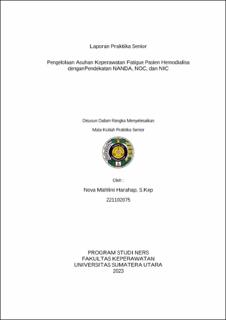Pengelolaan Asuhan Keperawatan Fatigue Pasien Hemodialisa dengan Pendekatan NANDA, NOC, dan NIC
| dc.contributor.advisor | Tumanggor, Roxsana Devi | |
| dc.contributor.author | Harahap, Nova Mahlini | |
| dc.date.accessioned | 2024-03-01T07:13:56Z | |
| dc.date.available | 2024-03-01T07:13:56Z | |
| dc.date.issued | 2023 | |
| dc.identifier.uri | https://repositori.usu.ac.id/handle/123456789/92107 | |
| dc.description.abstract | Hemodialysis is a therapy for patients with end-stage renal failure. Hemodialysis therapy will cause side effects, one of which is fatigue. The effect of fatigue or tiredness experienced is a person's lack of ability to carry out daily activities or physical activities, as well as disrupting the survival of patients undergoing hemodialysis. Implementation of nursing care for fatigue patients with the NANDA, NOC and NIC approaches can streamline the work of nurses. The diagnoses that are enforced in fatigue are fatigue, excess fluid volume and insomnia. NOC in the diagnosis of fatigue, namely fatigue: disturbing effects; on excess fluid volume, namely excess fluid and on the diagnosis of insomnia, namely psychomotor sleep and hope. NIC for fatigue diagnosis namely energy management; excess fluid volume, namely fluid management, fluid monitoring and nutritional management as well as for the diagnosis of insomnia, namely increased sleep | en_US |
| dc.language.iso | id | en_US |
| dc.publisher | Universitas Sumatera Utara | en_US |
| dc.subject | fatigue | en_US |
| dc.subject | Nursing Care | en_US |
| dc.subject | Hemodialysis | en_US |
| dc.subject | SDGs | en_US |
| dc.title | Pengelolaan Asuhan Keperawatan Fatigue Pasien Hemodialisa dengan Pendekatan NANDA, NOC, dan NIC | en_US |
| dc.type | Thesis | en_US |
| dc.identifier.nim | NIM221102075 | |
| dc.identifier.nidn | NIDN0010087907 | |
| dc.identifier.kodeprodi | KODEPRODI14901#Profesi Ners | |
| dc.description.pages | 59 Pages | en_US |
| dc.description.type | Karya Tulis Profesi | en_US |
Files in this item
This item appears in the following Collection(s)
-
Profession of Nursing [294]
Profesi Keperawatan




